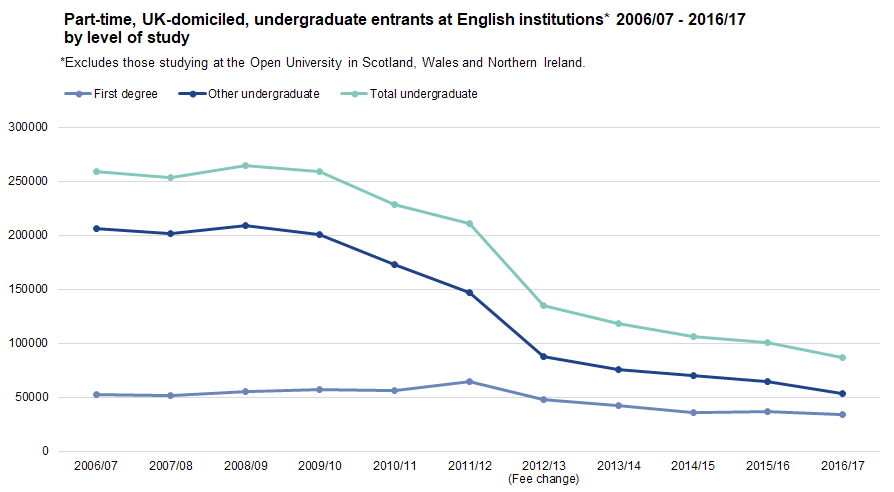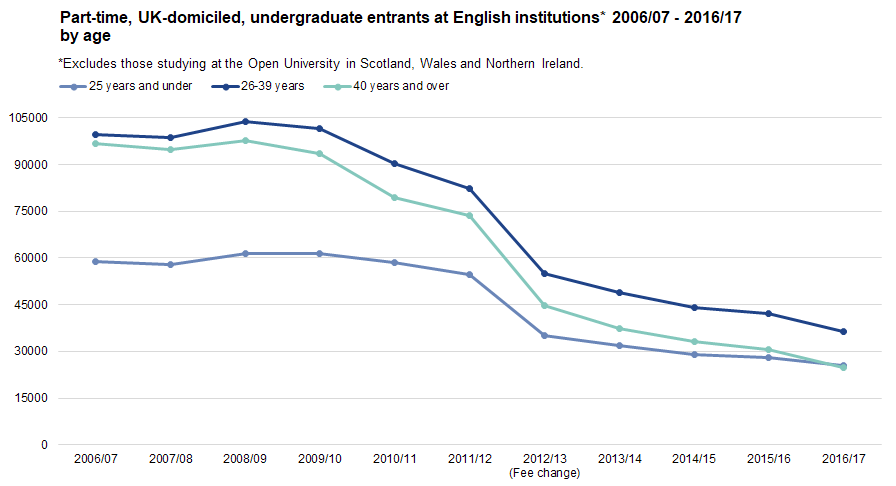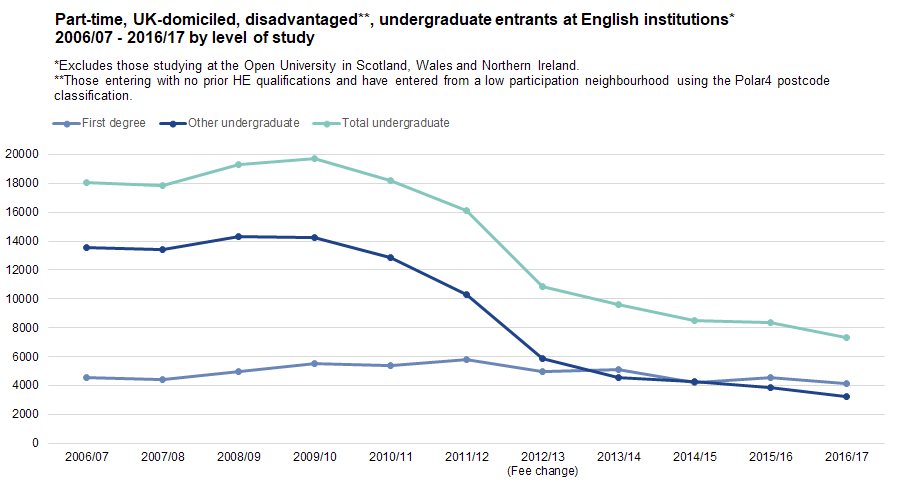Research Update: Part-time data analysis from HESA and CFE Research
Welcome to the first update from the research team at HESA and CFE Research who are looking at effective part-time provision for UK domiciled, undergraduates in English institutions, particularly those from disadvantaged backgrounds. If you missed it, the initial announcement of the research being undertaken for OFFA (Office for Fair Access) can be read here.
The scale of the challenge facing the sector is starting to become increasingly clear.
This project update will showcase some of the secondary analysis undertaken on HESA’s existing 2006/07-2016/17 part-time data. While the fall in part-time provision is well documented, the scale of the challenge facing the sector is starting to become increasingly clear.
A concerning overall picture

The latest 2016/17 data shows another significant fall in part-time entrants rather than a flattening off.
We can see that much of the part-time undergraduate decline is being driven at the other undergraduate level with first degree numbers (albeit mostly at the Open University) remaining relatively static in comparison. A breakdown of the first-degree data to assess this trend further will be available in future releases. While a large reduction of entrants was seen after the tuition fee rise in 2012/13, the decrease in part-time entry numbers had started well before then in 2008/09 and has continued. The latest 2016/17 data shows another significant fall in part-time entrants rather than a flattening off, or recovery, which must be a serious concern for the sector. This is in stark contrast to the equivalent full-time data which in 2016/17 shows there are more undergraduate entrants than ever before – even before the tuition fee increase in 2012/13. These findings imply several important questions:
- Is the demand for part-time courses reducing?
- Is there a lack of supply of part-time courses?
- Is it a mixture of both supply and demand factors combining to exacerbate the decline?
We will consider these questions further as the research progresses through our institutional case studies and survey of existing part-time students.

A declining mature market
The tuition fee change in 2012/13 hit the 40 years and over age group hardest and more students are now entering part-time study aged 25 and under than those 40 and over.
We see that while the tuition fee change in 2012/13 hit all age groups, the 40 years and over age group has been hit hardest and more students are now entering part-time study aged 25 and under than those 40 and over. To put that in perspective, in 2006/07, almost 38,000 more entrants were aged 40 and over than 25 and under. In the latest 2016/17 data, we see a further visible dip in older learners entering the market. The sector must therefore consider the factors that may be switching mature learners off this type of study – for instance, are the numbers studying for self-interest reducing, or are retraining opportunities becoming restricted? We will explore in more detail how part-time study is being funded and the changing reasons for studying part-time as the research progresses.
Defining disadvantage
One of the challenges facing the research team has been how to define disadvantaged students in a part-time context using existing measures. Many of these measures such as socio-economic classification and parental education are often incomplete and more suited to younger entrants. We know from existing HESA data that the age profile of the part-time market is higher which makes these measures less effective – especially if used in isolation.
We therefore decided to use a combination of the existing measures to define a part-time disadvantaged group:
- Low-participation neighbourhoods (POLAR 4) – Looks at the number of 18 and 19-year olds entering higher education between 2009/10 and 2014/15 for each postcode area. This is often referred to as a participation rate and postcodes with the lowest entry numbers are classified as low participation neighbourhoods.
- Highest qualification on entry - Looks at the highest qualification a student enters a higher education course with. This can range from no formal qualifications to postgraduate qualifications.
We looked at those who entered part-time courses with no prior HE qualifications and entered from areas that were classified as low participation neighbourhoods, according to POLAR4. We wanted to see if the trends for this disadvantaged group remained the same as the wider part-time population.

Because of the decline in the number of other undergraduate entrants, the number of first-degree entrants is now higher.
We can see an even sharper decline in other undergraduate entrants in the disadvantaged group. The decline is so drastic that first-degree entrants now outnumber those at other undergraduate level. The robustness of these findings is something we wanted to test further so we looked at data relating to the adult HE qualification classification combined with entry qualification information. The benefit of this alternative measure is that it may be more appropriate for part-time students given their higher age profile, although it is based on older data and uses a wide-ranging age category.
- Adult HE Qualification Classification – Looks at the proportion of people aged 16-74 who have HE qualifications from the 2001 census. It uses a postcode classification to group areas where this proportion is lowest right up to where it is highest. These groups are known as quintiles and quintile 1 refers to areas where the proportion is lowest.
We looked at entrant numbers to part-time courses from areas in quintile 1 who had no prior HE qualifications, observing similar trends to our own created measure, with other undergraduate numbers declining sharply. This eased our concerns about using POLAR to measure disadvantage in a part-time context as it has been combined with both highest qualification on entry and adult HE qualification measures in the analysis. While a measure of disadvantage that is tailored around part-time education would further strengthen this work, the results still pose some important questions for the sector such as:
- Why do other undergraduate courses now feel less appealing for disadvantaged students when choosing to study part-time?
- In which subjects are entry numbers collapsing, and what will the knock-on effect be for skills in our economy?
For example, we know from existing HESA data that entry into Nursing courses continues to decline, so what impact will this have on skills shortages within the NHS, particularly in light of Brexit? We will consider these questions further as the research progresses.
Looking ahead
We have distributed our online survey to current part-time students to gauge their views on part-time provision and will link their responses to the existing HESA data. We will also start our institutional case studies looking at existing provision and how it has changed over time. This will help us begin to build a bigger picture of the part-time HE sector which will feed into reports and further releases to come.
Thank you for all your support as a community in helping us to share this valuable work with the sector. Our thanks must also go to our advisory group who met for the first time recently and continue to support the project. We will be back again with another update in the coming weeks.
Data note
Where data is unknown, it has been excluded from individual breakdowns.
Related content

Matt Clarke
